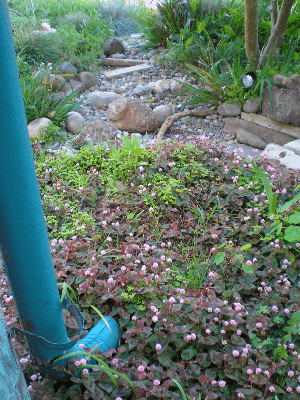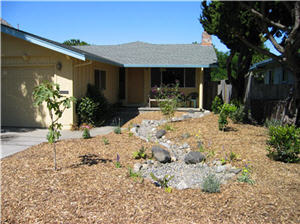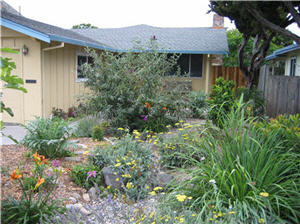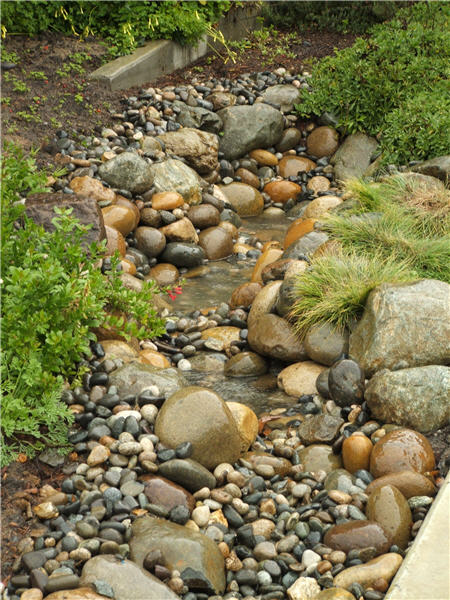- TABLE OF CONTENTS
- REDUCE YOUR WATER NEEDS
- Use Drought Tolerant Plants
- California Native Plants
- Climate Zones
- Reduce or Replace Lawn
- Artificial Turf
- IRRIGATE EFFICIENTLY
- Water Needs of Plants
- Before You Design
- Types of Irrigation Systems
- Weather Based Irrigation Controllers
- Working with an Irrigation Contractor
- DEVELOP ALTERNATE SOURCES OF WATER
- RETAIN WATER IN THE LANDSCAPE
- Build Retaining Walls
- Mulch to Reduce Evaporation
- Install Permeable Hardscapes
- Amend Soil with Organic Materials
- KEEP YOUR WATER PURE
- Drainage
- Eliminate Runoff and Overspray
- Slow it, Spread it, Sink it
- Ocean Friendly Gardens
- Rain Gardens
- Swales
- Keep Your Watershed Beautiful
- Soil
- Pests
- Select Plants that Don't Need Chemicals
- ADDITIONAL GARDENING RESOURCES
Rain Gardens
Create Rain Gardens (from Slow it, Spread it, Sink it! A Homeowner’s Guide to Greening Stormwater Runoff, Resource Conservation District of Santa Cruz County).
 |
A rain garden is a specialized landscape design that captures stormwater runoff from roofs, driveways, or other impervious surfaces and allows water to SINK back into the ground. It uses plants to remove pollutants and improve infiltration allowing water to soak back into the ground. In soils with low permeability this system may be used to temporarily store water (not completely infiltrate) and remove pollutants before they enter a waterway.
A rain garden design can be as simple as a shallow depression filled with plants that can flourish in both moist and dry conditions. The required size, shape, and depth of the garden depend on how much water you are trying to capture. For large amounts of runoff or areas with insufficient infiltration, there are a full spectrum of engineered features, such as specialized soil mixtures, an aggregate base, and subsurface drains that can be added. These more complex designs are often referred to as bioretention cells.
Plant the center of the garden with species that tolerate wet conditions, such as native sedges and rushes. Around these, put plants suited to occasional standing water, like Yellow Monkeyflower (Mimulus guttatus) or California Aster (Aster chilensis). At the furthermost edges there are a variety of native evergreen and deciduous shrubs that prefer drier soil. Use the Plant selection tool to choose plants that need dry soil. Rain gardens should be located at least 10 feet from your house and at least 40 feet from a septic system or steep slope. They should also be designed to drain within 48 hours to reduce the risk of standing water and mosquito breeding. Rain gardens are a beautiful way to protect your property from erosion and protect the water quality of local creeks. They can enhance the aesthetic value of a site; be used on small parcels of land, easements, and right-of-ways; and are easily incorporated into existing landscapes or open space.
 Before |
 After |
Location: Santa Cruz
Designer: Love’s Gardens
Installation: Love’s Gardens
MAINTENANCE: Routine maintenance is required and can be performed as part of the regular site landscaping program. Weeding and irrigation are essential in the first couple of months while plants become established. Annual pruning and mulching are recommended. Additional irrigation may be necessary during drought years. The use of native, site-appropriate vegetation reduces the need for fertilizers, pesticides, excessive water, and overall maintenance.
DO
Use California native or drought tolerant plants as appropriate.
Minimize fertilization to prevent water contamination and try organic options.
DON’T
Site in soils with high water tables or clay soils without an overflow device.
Place too close to your home’s foundation.
 |
Location: Capitola
Designer: Raison Cain and Habitat Gardens
Installation: Creative Landscapes and Habitat Gardens